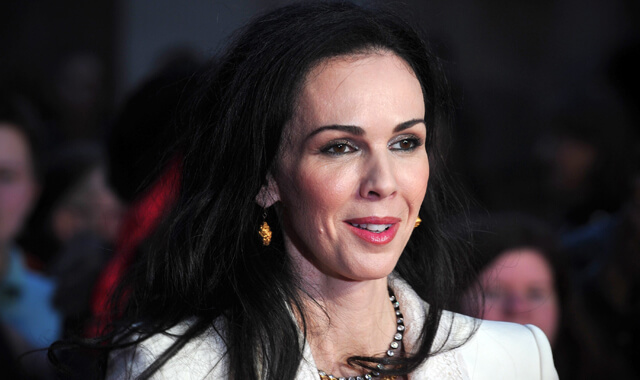

Celebrity
L’Wren Scott Never Wanted to Be Identified As “Someone’s Girlfriend”
No matter how accomplished, women are always remembered for the men in their lives.
This article was made possible because of the generous support of DAME members. We urgently need your help to keep publishing. Will you contribute just $5 a month to support our journalism?
L’Wren Scott was a self-made fashion designer and stylist who dressed Michelle Obama, Angelina Jolie and Sarah Jessica Parker, who broke out of her Mormon enclave at age 18 after a chance meeting with the fashion photographer Bruce Weber to become a big-time runway model for Karl Lagerfeld and Thierry Mugler, but on the day of her death from apparent suicide at age 49, Scott’s most notable accomplishment, according to the media, was being Mick Jagger’s girlfriend. Wait, seriously?
Just what every successful woman wants chiseled on her gravestone: “Herein lies the girlfriend of a man more famous than she.”
News outlets on Monday could barely constrain themselves from trumpeting Scott’s association with the Rolling Stones frontman, sometimes even blasting it in the headline as if her relationship with a huge celebrity were the primary reason to grieve or care. “Mick Jagger’s girlfriend L’Wren Scott found dead,” according to the BBC. “L’Wren Scott, noted fashion designer, Mick Jagger’s girlfriend, found dead,” from CNN. “L’Wren Scott, designer and Jagger’s girlfriend, found dead,” reported USA Today. These are all major news organizations that should know better than to give her own accomplishments, formidable in an industry just as glamorous as rock ’n’ roll (but maybe not as interesting to most hetero men so I guess it doesn’t matter as much), equal billing with her romantic proclivities.
On Twitter, where all sins of society are shamed at least for a few hours, readers and fellow journalists responded to the imbalance. When @NYTStyles initially tweeted about Scott’s death without bothering with her name, only “Mick Jagger’s girlfriend,” Harper’s Bazaar executive editor Laura Brown shot back, “Hey NYT, her name is L’Wren Scott.”
This regrettable style of summing up a woman by her relationship with a man is nothing new for media coverage of notable deaths. Last year, the New York Times came under fire for kicking off an obituary on rocket scientist Yvonne Brill with a laundry list of her domestic skills. (First line: “She made a mean beef stroganoff, followed her husband from job to job, and took eight years off from work to raise three children.”) The obituary editor mansplained that the lede was meant to highlight the improbability of a mother also being a rocket scientist—but that only made it worse. It shouldn’t be a shock that a woman so adept in one arena of her life was equally adept in another because this is the kind of thing women do every damn day. Yep, even in the ’50s when the glass ceiling may have limited them to less prestigious careers, plenty of women were killing it on all fronts.
It’s high time to propose a test for obituary writers, similar to the Finkbeiner Test: If you wouldn’t write the headline the other way around (“L’Wren Scott’s boyfriend Mick Jagger found dead,” which is preposterous just to type), don’t think you’re justified in writing it that way for the female half. Even the AP Stylebook entry on covering women, written some 40 years ago, states the obvious: “Use the same standards for men and women in deciding whether to include specific mention of personal appearance or marital and family situation.” Too often this is ignored in a culture taught to portray every woman’s success as an anomaly or at least secondary to her traditional duties of wife and mother.
What’s particularly galling about shortchanging Scott’s achievements is that her life story is the stuff of modern-day fairytales. Girl adopted by Mormon family teaches herself to sew in small-town Utah so that second-hand clothes could fit her six-foot-four frame. After she gets spotted by Weber who’s shooting on location, girl flies off to Paris to become the toast of the catwalk—strutting for Mugler, Lagerfeld, and posing for French and Italian Vogue. Years later, after working with Herb Ritts as a stylist and working on costume/wardrobe in movies including Eyes Wide Shut, she’s named the official stylist for the Oscars in 2000. And yes, throw in there her celebrity friends (but not first, never first) and you’ve got a recipe for a vivid, only-in-dreams life.
At the end, Scott may not have seen the beauty of her story, choosing instead to hang herself on a doorknob with a scarf. It’s sad that even on her final day, the press didn’t recall how she once described herself: “I’m a fashion designer. I don’t want to be defined as someone’s girlfriend.”
Before you go, we hope you’ll consider supporting DAME’s journalism.
Today, just tiny number of corporations and billionaire owners are in control the news we watch and read. That influence shapes our culture and our understanding of the world. But at DAME, we serve as a counterbalance by doing things differently. We’re reader funded, which means our only agenda is to serve our readers. No both sides, no false equivalencies, no billionaire interests. Just our mission to publish the information and reporting that help you navigate the most complex issues we face.
But to keep publishing, stay independent and paywall free for all, we urgently need more support. During our Spring Membership drive, we hope you’ll join the community helping to build a more equitable media landscape with a monthly membership of just $5.00 per month or one-time gift in any amount.




















































































